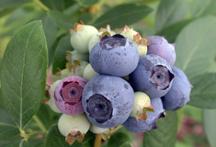Blueberries are native to Eastern North America. They are one of the few crop plants that originated here. The rabbiteye blueberry occurs mostly in certain river valleys in Northern Florida and Southeastern Georgia. The high bush blueberry is native to the eastern third of the United States and Southeastern Canada. Florida is rich in other native species. The woods and swamps of Florida are populated with at least eight wild blueberry species. No area of the state lacks wild blueberries, except where soil pH is above 6.0.
The two types of blueberries grown in Florida are Southern highbush and rabbiteye. The earliest ripening southern highbush varieties ripen about 4 to 6 weeks earlier than the earliest rabbiteye varieties grown at the same location.
Some rabbiteye varieties recommended for our area are: Alice blue, Beckyblue, Climax, Bonita, Brightwell, Chaucer and Tifblue. Some recommended Southern Highbush varieties are: Blue Crisp, Gulf Coast, Jewel, Sharpblue, Santa Fe, Star and Misty.
Blueberries need a fairly acid soil; a pH range of 4 to 5 is suggested. Blueberries grown on alkaline or deep sands will grow poorly. If you need to lower the soil pH before planting, mix in some acidic peat moss.
Blueberries have a shallow, fibrous root system. That means plants should be placed in the ground about an inch deeper than they were growing in the nursery. Rabbiteye blueberries grow poorly in soils with excessive drainage. But they won’t tolerate too much moisture for long periods of time either.
Blueberries are very sensitive to fertilizers. During the first growing season, no mineral fertilizer should be added at all. In the second season, apply about two ounces of an acidic fertilizer per plant. Blueberries can use the same fertilizer as camellias and azaleas, but be careful not to overdo it. Excessive amounts of fertilizer will kill the plants.
Before planting blueberries, you should cultivate the soil by plowing or roto tilling to a depth of at least six inches. Dig a hole large enough so that the roots won’t be crowded. Lightly pack the soil around the roots and water thoroughly. Keep in mind that newly set plants need a good water supply.
Bare-root bushes should be transplanted during the winter months; container grown bushes can be transplanted anytime. The first year after planting, the blossoms should be removed to help the bush grow more quickly.
Pruning is an important part of blueberry culture. It promotes the growth of strong wood, and rids the tree of weak twiggy growth. The strong wood growth is necessary for good fruit production.
Believe it or not, the worst pests of blueberries are birds. You need to protect your bushes with some kind of netting, or employ the old fashioned scarecrow to do the job. It you don’t protect your bushes, you can count on the birds getting to the fruit before you do.
Other than birds, rabbiteye blueberries have few pest or disease problems. Powdery mildew can occur on bushes that don’t get full sun, but this problem can be easily controlled with a sulfur spray. Bud mites, thrips, fruitworms, and defoliating insects can sometimes be a problem.
Weeds will compete with young blueberry bushes for nutrients and water, so keep the beds as free of weeds as possible. Mulches are good for controlling weed growth. If necessary, there are herbicides available.
For more information please see:
- Muscadine Grape: a Popular Fruit for North Florida - August 10, 2015
- Southern Field Peas, a Summer Delight - July 14, 2015
- Caterpillars with a Sting - June 10, 2015

